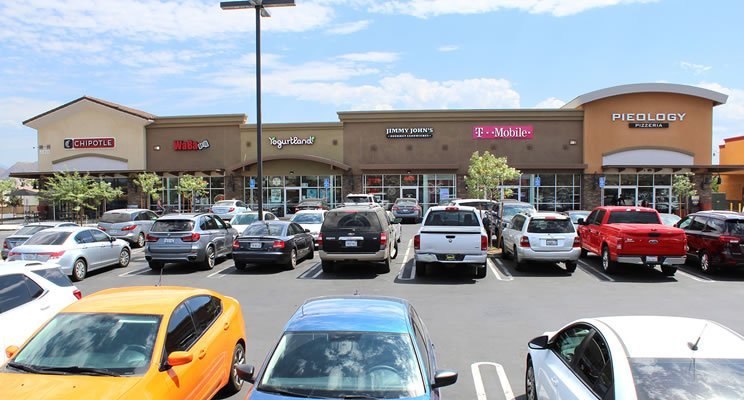This post originally appeared on tBL member SCGWest’s blog and is republished with permission. Find out how to syndicate your content with theBrokerList.
Do you own a shopping center that’s underperforming? Are you struggling with vacancies or unprofitable tenants?
Or is your shopping center doing OK, but you’re pretty sure it could be more profitable if you made some changes?

If any of these apply to you, it may be time to think about redeveloping your shopping center! Redevelopment can involve giving the property a significant overhaul (think a full rehabilitation), or it could involve repurposing and changing its use.
Whether you do one or both of these, redeveloping your shopping center can definitely lead to a higher NOI. And for commercial property owners, that’s what really matters, right?
Should I redevelop my shopping center?
As with most questions in real estate, there’s no hard and fast answer. Your shopping center probably already has several things going for it, or you wouldn’t have invested in it in the first place. Location, visibility, and the demographics of the area can give you a leg up on the competition, even if you’re competing with brand new or bigger developments.
So with that in mind, there are several things you need to research and evaluate carefully before you decide to redevelop. The earlier you can start researching these issues, the better. There could be several things that need to be resolved before you can redevelop, and some of them may take a lot of time. A commercial real estate broker can be a valuable partner as you start to explore redevelopment.
- Analyze your existing leases
Can they accommodate redevelopment? Tenants have rights to their space, of course, for the duration of their lease. So it’s important to thoroughly review the leases and understand what you can and can’t do while they are in effect.

- Give some real thought to your mix of tenants
A redevelopment project gives you the opportunity to bring in a complementary, profitable mix of tenants. You should give this a lot of thought, because the right mix of tenants can significantly increase your NOI. Also think about whether you’re prepared to offer incentives to attract high-value tenants, and how that will factor into your redevelopment budget.
- Consider the highest and best use of the property
This is something a commercial appraiser can help you with. Basically, it’s a study to determine the most feasible and profitable use of the property – and this is something that can change over time. So if your shopping center has been a shopping center forever, maybe it’s time to rethink that and see if there’s a potentially better use for it that will bring you more value.
- Existing financing
Do you have an existing loan(s) on the property? Your lender will want to make sure that your cash flow continues uninterrupted, so a redevelopment that interferes with cash flow may not be permitted.
- Entitlement and zoning
Significant renovations, change of use, and demolition / rebuilding will all need to be entitled – that is, you’ll need to get the necessary approvals to proceed with the work. The entitlement process can be lengthy, especially if it involves rezoning or getting zoning variances. This will definitely need to be something you plan for when you’re redeveloping.
- Demographics
A shopping center full of stores that cater to young families isn’t likely to do well in an area populated with tons of empty nesters – and the demographics of an area can also change over time. So it’s important to consider that when you’re redeveloping your property, so that you can work to attract tenants that are a good fit for the area. Just because something was a good fit 15 years ago doesn’t mean it still is – so engage with a real estate broker who can analyze this for you.
What are some possible redevelopments?
Since redevelopment could involve rehabbing your shopping center or converting it into different uses, there are a lot of possibilities. But these will be limited by things like zoning and competition, too, so it’s important to really know your market and understand the types of businesses it can support.
One prominent trend among owners of shopping centers is redeveloping them for new, different uses. A quick scan of your local business news will show you that this type of redevelopment, often called adaptive reuse, is becoming more and more common as property owners seek to get the most ROI and diversify their investments, and keep up with changes in the market. (You can see some examples of large-scale mixed use redevelopments here and here).
This type of redevelopment often involves converting from just retail to mixed use. Mixed use developments include at least two different uses, and usually more: housing, office, retail, hospitality, and medical are all common components of mixed use developments.
Mixed use developments are in high demand. As consumers become more concerned about issues such as climate change and wellness, they’re looking for more walkable and bikeable neighborhoods – and mixed use developments contribute to these types of neighborhoods by allowing people to accomplish a variety of tasks in one place.
Redeveloping your shopping center could result in new, long-term tenants that you wouldn’t even have thought of ten years ago – like coworking and healthcare. “Medtail” clinics, or medical facilities in retail locations (or former retail locations) are hugely popular and are only going to increase in popularity. Consumers love the convenience of medtail clinics, and having a medtail clinic as a tenant gives you stability and allows you to tap into a growing market sector.

Consider this quote from a 2019 article by CCIM Institute: “Retail success in its next iteration will be defined by alignment with services – services like hospitality, transportation centers, health care, and education.” Shopping centers can be redeveloped into both retail and service-oriented hubs that attract a variety of customers and contribute to the types of experiences that customers want.
How can redeveloping my shopping center increase NOI?
We’ve written before about the benefits of remodeling a restaurant or retail business, and they can be significant. Updated spaces are more attractive to both tenants and their customers, so rehabilitating a shopping center may well give it the refresh it needs to attract more shoppers.
To recap, here are a few of the numbers from that previous article:
- According to Delaget, after a remodel, sales can increase 15-40%.
- Wendy’s stores that were remodeled saw sales increases of 10-20%, and stores that were completely rebuilt realized gains of 25-30%.
- In one study, retail stores that remodeled saw a big increase in new customers, who spent more money per visit and returned more often than existing customers did.
In general, a redeveloped shopping center will command higher rents. This is great for you as a landlord, both in terms of base rents and percentage leases, if you use them, since more sales for your tenants = higher rents for you. Redeveloping your shopping center may even allow you to incorporate some features that tenants are finding highly desirable post-pandemic, like drive-thrus and patios.
Another big plus is that if you redevelop and rehabilitate your shopping center, new HVAC, electrical and plumbing systems will cost less to maintain than older ones. And it’s also a great chance to upgrade energy efficiency features in the building, like windows, doors, and insulation.
Redeveloping your shopping center may also give you the chance to attract more stable, profitable tenants.
ᔓ
Redeveloping your shopping center gives you the chance to build a solid, market-based foundation for your investment, but it must be done with expert planning and careful analysis. The current trend of redeveloping and repurposing shopping centers doesn’t seem to be going anywhere, so if you own a shopping center, it’s time to start thinking about the future to make sure you stay competitive and profitable.



